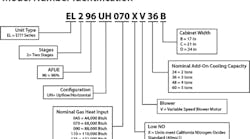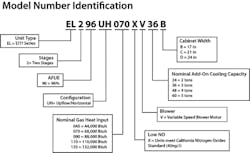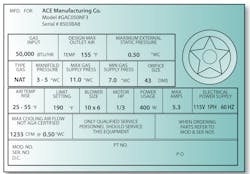Each piece of HVAC equipment has a nameplate containing features and details. The problem is, this information is imbedded in the model number and must be interpreted to be useful. By learning to interpret the code, you can increase your ability to repair, test, diagnose, and sell upgrades. Let’s take a look at how to read and interpret equipment nomenclature. Example is available as a download at the end of this article.
What’s in a Model Number?
Although each manufacture’s nomenclature is a little different, here is a sample from a Lennox gas furnace that provides an example of what each of the numbers and letters represent.
Equipment Type or Series
Most model numbers begin with the series or equipment type. Consider the EL in this model number as a code name for a group of similar equipment. These letters or numbers group equipment into categories such as furnaces or air handlers. Condensing units, heat pumps, cooling or heating coils, and package units also follow this pattern.
With less than an hour’s study on your manufacturer’s website, you will begin to identify the characters used to classify the equipment types your company offers. Once you master the nomenclature of your favorite manufacturer, it becomes easy to find and learn others.
Stages
In this example, the equipment stages are typically identified by a number or symbol in the model number. One digit or number buried within the nomenclature can be trickier to spot than a sequence of numbers or letters.
AFUE
Two numbers in gas-fired equipment typically identifies its AFUE rating. When testing, remember this is only a laboratory rating and rarely equals actual installed equipment performance. Once installed into a building, the effects of the distribution system bears on the equipment.
Configuration
Several methods are used to identify equipment configuration. Equipment is made to be installed in an upflow, downflow, or horizontal position. Manufacturers also refer to multi-position equipment that may require field modifications.
Nominal Gas Input
Most often the input (not output) of a gas furnace is imbedded in the model number by rounding off the Btuh. input to the nearest 5,000 and then dropping the last three zeroes. The example above includes 070 to represent a 68,000 Btuh. rated gas input capacity.
California’s NOX Compliance
Good ‘ol California leads the nation in regulations including Nitrogen Oxide requirements. Seismic standards are also stated in some equipment nomenclature. These are identified by numbers or letters depending on each manufacture’s nomenclature patterns.
Nominal Add-on Cooling Capacity
Since the example above is a gas furnace, the cooling capacity matching the outdoor unit is referred to in the model number. This is where the classic numbers representing 12, 000 Btu/ton come into play such as 24 (representing 24,000 Btu or a nominal 2 ton cooling capacity) 30 (2.5 ton), 36 (3 ton), 42 (3.5 ton) , 48 (4 ton) and 60 (5 ton).
When interpreting air-moving equipment model numbers a variety of numbers and letter methods are used to represent fan capacities. For example, some manufacturers use numbers to represent nominal fan cfm capacity; 08 represents 800 cfm, 10 represents 1000 cfm and so on.
Other manufacturers only provide fans rated by even nominal tonnage airflows such as 2, 3, 4, and 5. Using this method, a 3 in the model number at the correct location indicates a 3-ton fan having a standard rated airflow of 1200 cfm.
One manufacturer is now using a letter to indicate the typical tonnage airflow at sea level such as B, C, D, E, F, G, H, I, and J. These correspond with the traditional 2, 2.5, 3, 3.5, 4 and 5-ton fan ratings at 400 cfm per ton.
But Wait, There’s More…
Remember, this example is just for this gas furnace. There are much more data included in the model numbers. The components and features represented vary from one manufacturer to another and from one type of equipment to another.
These may include:
- Coil options
- Fuel types
- Indoor fan options
- Sensor options
- Electrical options
- Additional accessories.
Where to find this information?
As time passes and search engines improve, accessibility to this information is increasing. Often, you can just enter the equipment model number into your favorite search engine and the specification will appear. Facts describing nameplate detail as shown in the example at the beginning of this article are available on each manufacturer’s website.
Several manufacturers websites require a password and registration and may take as long as two days to receive access, so be patient.
Changes are coming. For example, one manufacturer is eliminating the product number and using only the equipment model numbers to identify features. ASHRAE 205P is being developed to standardize manufacturer specifications and performance data as demand for access to this valuable data is increasing at an alarming rate.
One thing is for sure, as the industry moves forward, unless you develop the ability to interpret model numbers and use that information daily, your career will be limited.
Rob “Doc” Falke serves the industry as president of National Comfort Institute, Inc., an HVAC-based training company and membership organization. If you're an HVAC contractor or technician interested in a free test procedure describing simple testing you can do on a sales visit, contact Doc at [email protected] or call him at 800-633-7058. Go to NCI’s website at nationalcomfortinstitute.com for free information, articles, and downloads.











